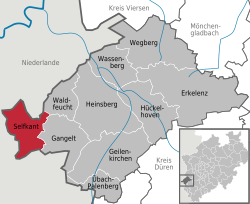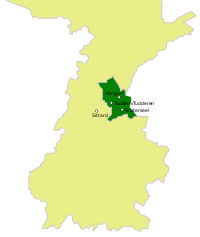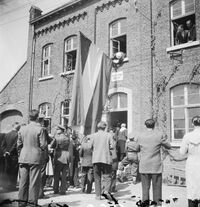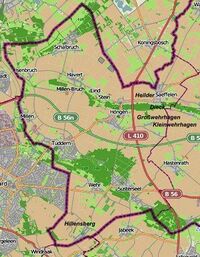زلفكانت
Selfkant | |
|---|---|
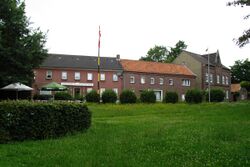 | |
| الإحداثيات: 51°1′N 5°55′E / 51.017°N 5.917°E | |
| البلد | ألمانيا |
| ولاية | شمال الراين - وستفاليا |
| المنطقة الإدارية | Köln |
| المقاطعة | Heinsberg |
| التقسيمات | 16 |
| الحكومة | |
| • Mayor (2020–25) | Norbert Reyans[1] (CDU) |
| المساحة | |
| • الإجمالي | 42٫08 كم² (16٫25 ميل²) |
| المنسوب | 69 m (226 ft) |
| منطقة التوقيت | UTC+01:00 (CET) |
| • الصيف (التوقيت الصيفي) | UTC+02:00 (CEST) |
| الرموز البريدية | 52538 |
| مفاتيح الهاتف | 02456, 02455 (Saeffelen) |
| لوحة السيارة | HS |
| الموقع الإلكتروني | www.selfkant.de |
زلفكانت ( Selfkant ؛ ألمانية: [ˈzɛlfkant] (![]() listen)؛ هولندية: Selfkant أو Zelfkant [ˈzɛl(ə)fkɑnt]؛ بالليمبورگية: Zelfkantj li) هي بلدية في مقاطعة هاينزبرگ، في شمال الراين - وستفاليا، ألمانيا. وهي أقصى بلدية ألمانية إلى الغرب.
listen)؛ هولندية: Selfkant أو Zelfkant [ˈzɛl(ə)fkɑnt]؛ بالليمبورگية: Zelfkantj li) هي بلدية في مقاطعة هاينزبرگ، في شمال الراين - وستفاليا، ألمانيا. وهي أقصى بلدية ألمانية إلى الغرب.
الجغرافيا
Isenbruch in Selfkant is the most westerly point in Germany since 1919; before that, the position was held by Gravelotte، في ألزاس-لورين. حدود زلفكانت مع هولندا يبلغ طولها 27 كم، بينما حدودها مع باقي ألمانيا يبلغ طولها 6 كم فقط.
التاريخ
The most important domain in Selfkant in the Middle Ages was the castle and village of Millen, the residence of the lords of Millen, which became part of the domain Heinsberg in 1282. In 1499 these were joined by the duke of Jülich and Millen became the seat of an Amtmann. The places Tüddern, Wehr, Süsterseel and Hillensberg belonged to the Amt Born and after 1709 to the Amt Sittard.
من 1794 وحتى 1815، كانت زلفكانت جزءاً من كانتون سيتار الفرنسي (department of the Roer). بعد مؤتمر ڤيينا أصبحت جزءاً من مقاطعة الراين الپروسية. الحدود مع هولندا التي كانت حـُلَّت، استمرت للتواجد حتى بعد الحرب العالمية الثانية بقليل.
تودرن
After the Second World War, on 23 April 1949, the Netherlands annexed Selfkant as part of war reparations, and its inhabitants were given a Dutch passport with the special indication "to be treated as a Dutchman". The Dutch government appointed a country landdrost to head the governing board of the Tüddern 'office', as the Selfkant was renamed for administrative purposes. The governing board appointed by the Germans was sent home because it was contrary to the Dutch constitution. However, as a transitional measure for ex-German territories, the German governing board retained an advisory role.
At that time much was invested in such things as houses and roads. Parts of the area became Dutchified, and the Dutch influence is still present.
In the Dutch period, the N274 road was built to provide a direct link between Roermond and Heerlen. Even after 1963 the road remained a narrow strip or corridor of Dutch territory with no junctions with German roads, and no passport was needed to use it. On 25 February 2002 the road was returned to Germany and in the course of 2004 connections were made with several roads, among others with the B56 between Gangelt and Süsterseel.
البلدية الألمانية
In March 1957 official negotiations started between the Netherlands and West Germany concerning the return of the area, and on 1 August 1963 the area was returned to Germany in exchange for a payment of 280 million deutschmarks. From the existing 'office' of Tüddern the old municipalities of Havert, Hillensberg, Höngen, Millen, Süsterseel, Tüddern and Wehr were formed. Two months later, on 21 October 1963, the first municipal council elections under German authority were held.
The seven municipalities, with the municipality of Saeffelen from the Amt Waldfeucht, were added to the municipality Selfkant on 1 July 1969.
With 233 inhabitants per km² Selfkant is considered a rural municipality. Because of the favourable price of land the municipality is nowadays very much in demand with young families. A lot of Dutch cross the border to build their own houses there. Roughly one quarter to one half of the inhabitants are Dutch. At the mayoral election of 2003 a Dutch inhabitant put himself forward as candidate.
Many residents are also stationed, work, or are family members of employees at the NATO Air Base in Geilenkirchen. Tüddern alone has over 30 American families with the Gem. Selkant having dozens more. Many Canadians at the NATO base also live in Selfkant. English is quite prominent as a third language to Dutch and German in the whole area.
معرض صور
المراجع
- ^ Wahlergebnisse in NRW Kommunalwahlen 2020, Land Nordrhein-Westfalen, accessed 21 June 2021.
وصلات خارجية
 Media related to زلفكانت at Wikimedia Commons
Media related to زلفكانت at Wikimedia Commons
- Pages using gadget WikiMiniAtlas
- Short description is different from Wikidata
- Coordinates on Wikidata
- Germany articles requiring maintenance
- البلديات in North Rhine-Westphalia
- Articles containing هولندية-language text
- Pages using Lang-xx templates
- Articles containing Limburgish-language text
- Heinsberg (district)


